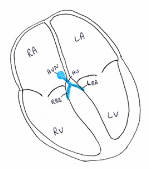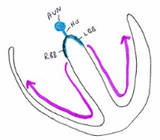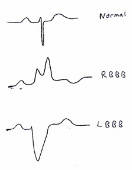Bundle Branch Block
I found this great article written by Richard N. Fogoros, M.D., About.com Guide, November 26, 2003, that I reprint here:
Causes, significance, and treatment
Bundle branch block (BBB) is a relatively frequent finding on the electrocardiogram (ECG). Sometimes BBB itself needs to be treated; sometimes it indicates significant underlying cardiac disease that needs to be treated; and sometimes it has so little significance that no treatment is necessary at all. In this article, we will review bundle branch block, its significance, and its treatment.
What are the bundle branches, and what do they do?
The bundle branches are an important part of the cardiac electrical system, the system that coordinates muscular contraction to assure that the heart works efficiently as a pump.
The Normal Cardiac Electrical System
Figure 1 – The Normal Electrical System: AVN = AV node, His = His bundle, RBB = right bundle branch, LBB = left bundle branch, RA = right atrium, RV = right ventricle, LA = left atrium, LV = left ventricle
To summarize, the heart’s electrical impulse originates in the in the sinus node in the upper right atrium, then spreads across both atria, then travels through the AV node. Leaving the AV node, the electrical impulse penetrates into the ventricles via the His bundle. From the His bundle, the electrical impulse enters the two “bundle branches” (the right and the left). The right and left bundle branches send the electrical impulse to the right and left ventricle, respectively. When the bundle branches are functioning normally, the right and left ventricles contract nearly simultaneously.
Figure 2 – The Normal QRS Complex
In this image of a normal ECG, the QRS complex represents the electrical impulse as it is being distributed, via the bundle branch system, throughout the ventricles. Since normally both ventricles receive the electrical impulse at the same time, the normal QRS complex is relatively narrow (generally less than 0.1 second in duration.)
Figure 3 – Normal Bundle Branch Conduction
To form this normal QRS complex, the electrical impuse needs to travel to both ventricles at the same time. The in this figure, purple arrows indicate the electrical impulse, traveling down the bundle branches and causing the ventricles to beat simultaneously.
BBB occurs when one of the bundle branches becomes diseased or damaged, and stops conducting electrical impulses; that is, a bundle branch becomes “blocked.” The chief effect of a bundle branch block is to disrupt the normal, coordinated and simultaneous distribution of the electrical signal to the two ventricles.
Right bundle branch block (RBBB)
In RBBB, the right bundle branch no longer conducts electricity. Therefore, as the electrical impulse leaves the His bundle, it enters left bundle branch only, and is carried to the left ventricle. Then, from the left ventricle, the electrical impulse finally makes its way to the right ventricle. As a result, the two ventricles no longer receive the electrical impulse simultaneously. First the left ventricle receives the electrical impulse, then the right.
Left Bundle Branch Block
Figure 4 – Left Bundle Branch Block (LBBB)
In LBBB, the opposite occurs. Here, the left bundle branch no longer conducts electricity. The electrical impulse thus enters right bundle branch, and is carried to the right ventricle (first panel). From there, it finally spreads to the left ventricle (second panel). Once again, the two ventricles no longer receive the electrical impulse simultaneously. First the right ventricle receives the electrical impulse, then the left.
With either type of BBB, therefore, the electrical signal spreads across the ventricles sequentially, as opposed to simultaneously. This sequential spread of the impulse (i.e., first the right ventricle, then the left – or vice versa) means that it takes longer for the impulse to reach throughout the ventricles.
The significance of Bundle Branch Block
Figure 5 – The ECG in BBB
In Figure 5, the top image shows a normal QRS complex. The middle figure shows RBBB, and the bottom figure shows LBBB. Note that with both kinds of bundle branch block, the QRS is wide and misshapen. The characteristic shapes of the QRS complex allow doctors to determine whether the right or the left bundle branch is blocked.
Why does the QRS complex change in BBB? The QRS represents the spread of the heart’s electrical impulse across the right and left ventricles. Because with BBB the ventricles receive the electrical impulse one after another instead of at the same time, it takes longer to form the QRS complex on the ECG. The QRS complex is said to “widen.” Also, since the pattern of the spreading of the electrical impulse is abnormal in BBB, the pattern of the QRS complex is also abnormal.
What is the significance of bundle branch block?
BBB is quite common, and occurs in a variety of medical conditions. RBBB occurs in medical conditions that affect the right side of the heart or the lungs, so a finding of RBBB on the ECG ought to trigger a screening exam for such conditions. These include blood clots to the lung (pulmonary embolus), chronic lung disease, cardiomyopathy, and atrial and ventricular septal defects. However, RBBB also commonly occurs in normal, healthy individuals, and the screening exam therefore often turns up no medical problems. In these cases, the RBBB has no apparent medical significance, and can be written off as a “normal variant,” and safely ignored.
In contrast, LBBB usually indicates underlying cardiac pathology. It is seen in dilated cardiomyopathy, hypertrophic cardiomyopathy, hypertension, aortic valve disease, coronary artery disease, and a variety of other cardiac conditions. While occasionally LBBB occurs in apparently healthy people, its appearance should trigger a thorough search (as opposed to a simple screening) for underlying cardiac problems.
If both the right and left bundle branches are completely blocked (i.e., “bilateral” BBB), the electrical impulse cannot reach the ventricles. In this case, unless spontaneous electrical impulses arise within the ventricles (a so-called “escape rhythm”), the ventricles stop beating and death occurs. Fortunately, this form of “complete heart block” is relatively uncommon.
In summary, the major significance of BBB is that it may indicate the presence of previously unknown underlying cardiovascular disease. When BBB is found, therefore, a search for such underlying disease ought to be carried out. Since RBBB often occurs in normal individuals while LBBB usually indicates underlying disease, the search for underlying disease generally should be more aggressive with LBBB than with RBBB.
Incomplete BBB, the Hemiblocks, and Treating BBB
Incomplete BBB
Sometimes either the right or the left bundle branch conducts the electrical impulse more slowly than normal, but is not completely blocked. When this occurs, on the side of the slow conduction, the electrical impulse arrives in the ventricle slightly later than normal. As a result, the QRS complex is slightly wider than normal, but not as wide as it would be with a complete BBB. This slight widening of the QRS is often called incomplete BBB. (Another name for it is an “intraventricular conduction defect,” or an IVCD.)
Incomplete bundle branch block sometimes indicates underlying heart disease. But, especially when it occurs on the right side (i.e., incomplete RBBB,) it often has no significance at all. So in general, incomplete bundle branch block should trigger a non-invasive search for underlying heart disease. If none is found, no further tests or treatment are needed.
The Hemiblocks
The left bundle branch itself divides into two major branches – the anterior and the posterior fascicles. Sometimes block can occur in just one of these fascicles. Such blockage is referred to as a hemiblock, or a fascicular block. (Note that the right bundle branch does not divide into discrete fascicles.)
When blockage is in the anterior fascicle, left anterior hemiblock (or left anterior fascicular block) is said to be present; whereas if the blockage occurs in the posterior fascicle, then left posterior hemiblock (or left posterior fascicular block) is said to be present.
Hemiblock generally does not widen the QRS complex, but instead changes the pattern of the QRS complex. (It alters the “axis” of the QRS complex. The axis is calculated by measuring the pattern of the QRS complex on several of the 12 leads acquired on a standard ECG.)
In general, finding a hemiblock should trigger a search for underlying heart disease. Often none is found, in which case the hemiblock can be ignored.
Treating BBB
As we have noted, the heart depends on the bundle branches. Without them, the electrical impulse is not delivered to the ventricles. Block in both bundle branches, therefore (a condition called complete heart block,) can be fatal.
Fortunately, it is quite uncommon for stable RBBB or LBBB to progress to complete heart block. Thus, despite the fact that BBB is a common finding on routine ECGs, it is an uncommon reason for implanting pacemakers.
Still, there are a few conditions in which people with bundle branch block require pacemakers:
1) When “conduction system disease” is bilateral, and is associated with a heart attack:We have previously noted that RBBB plus left anterior hemiblock should not be particularly alarming. This is true except in this one instance – where the block occurs acutely with a heart attack. Here, the conduction system disease tends to be unstable, and can progress to complete heart block. These patients often need pacemakers.
2) When bundle branch block is associated with syncope (loss of consciousness):When a patient with bundle branch block experiences syncope, in general an electrophysiology study should be considered to test for impending complete heart block. A permanent pacemaker eliminates the problem.
3) In certain patients with dilated cardiomyopathy:In patients who have dilated cardiomyopathy and either complete or incomplete bundle branch block, a new form of pacing – called cardiac resynchronization pacing or CRT – has now been shown to improve symptoms and to prolong life. CRT should now be strongly considered in any patient with heart failure and bundle branch block.
As we have seen, bundle branch block causes the ventricles to beat sequentially (one after another) instead of simultaneously. This discoordination of the normal pattern of ventricular contraction diminishes the efficiency of the heart beat. In a person with a normal heart, the loss of efficiency is inconsequential. But in a person with dilated cardiomyopathy this loss of efficiency can be critical, and can contribute greatly to symptoms of heart failure. Resynchronization pacing restores much of this efficiency by pacing both the right and left ventricles simultaneously. In patients who have heart failure from dilated cardiomyopathy and bundle branch block, resynchronization pacing has become an important component to therapy.
Dr T
http://www.cardiac-risk-assessment.com/
(From: By Richard N. Fogoros, M.D., About.com Guide, November 26, 2003)







Comments 3
Does RBBB impact or cause my high blood pressure and show up on readings?
I have been diagnosed with BBB but they did not tell me which side.I have had one episode of loss of consciencness and 2 or 3 near losses.Should I be concerned. The doc seems to think it is just blood sugar being too high and causing dehydration but my BS has not always been high when I have these spells.I also have chest pain with it
My husband just received notice that his Incomplete RBBB had changed to a RBBB. Should we be concerned? He does have HTN.